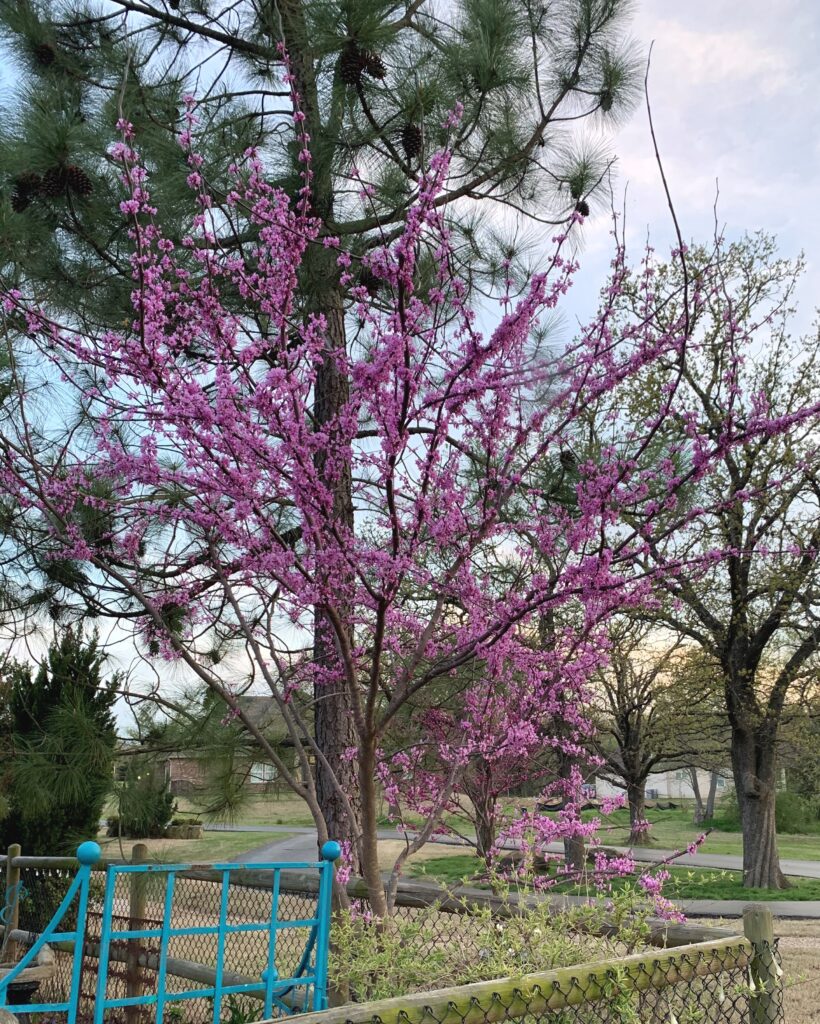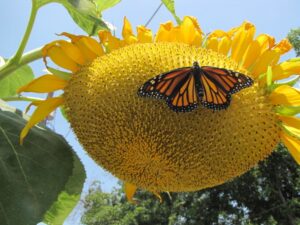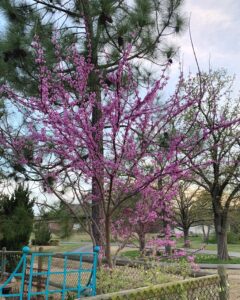Kathy Berryhill
Creek County Master Gardener
Fall is the best time to plant new trees. With the arrival of the forecasted cool temperatures, establishing new plants will be easier, and they will have time to acclimate before winter. Tree selection is based on many factors and due to their lifespan, the selection process should be carefully made.
Consider which tree will best serve your needs. What will be the tree’s primary function? Does the tree need to provide shade or serve as a privacy screen? Are you wanting to provide color during a specific season? Or maybe the tree is desired to help with soil retention. Answers to these questions will guide purchasing decisions.
The size of the tree is a top concern. Consider the full size of a mature tree when planting. Power companies routinely trim trees in their right away, destroying the visual appeal and sometimes the tree. If planting near a power line, choose a tree with a maximum growth that will not interfere with the power line. Size is a consideration near a house or other structure. To prevent continuing maintenance, plant far enough away so that the tree can mature to full size.
Research trees that thrive in our area. Most native trees can withstand our climate and do well in clay or sand. Strive for well suited trees that enhance the aesthetic quality of the landscape. Armed with a little knowledge and reading the plant tag can help ensure your success.
Oklahoma Proven, a plant promotion program coordinated by the Department of Horticulture and Landscape Architecture at OSU, recommends plants that are well-adapted for use across Oklahoma. A recommended native shade tree is the Shumard Oak. It has a moderate growth of 12-24” a year and grows to 50’ tall. The ‘Vanderwolf’s Pyramid’ Limber Pine, has the same color as a Blue Atlas Cedar, but is smaller and survives better in drought. Wildfire Blackgum is a native tree with bright red new growth and a fiery red fall show. A fast-growing Autumn Blaze Maple has upright branching and brilliant orange red, long-lasting fall color. The smaller Shantung Maple sports reddish purple leaves in the spring and bright yellow-orange in fall. A Chinese Pistache is a smaller, pest free option with orange-red fall color. The Oklahoma Redbud which has deep purple flowers in spring and yellow fall color is a widely adaptable, tough, durable small tree. These trees should be easily found at local nurseries. Note: avoid planting the overused Bradford Pear. This cultivar has cross pollinated with other trees and chokes out native trees and undergrowth.
When choosing a new tree, buy a minimum size of a five-gallon container to ensure established roots. Ensure that the root ball stays damp or moist until planting. Keep the soil around the roots intact when removing it from the container. If a tree is “stuck” in its pot due to growth, carefully score the sides of the pot to help release the plant. Always remove strings or wire around the root ball before planting.
Dig a hole that is 2–3 times wider than the diameter of the root ball. If the soil has clay, leave the root ball 1-2” above grade to help with drainage. Position the tree in the hole and replace the soil, gently working it under and around the roots to remove air pockets. Do not supplement the backfill dirt or apply fertilizer at this time. Gently firm the soil while filling until the hole is three-quarters full, and then fill the hole with water to settle the soil around the roots. After the water has soaked in, finish filling the hole with soil and water again. Young plantings need an inch of water per week during fall, but continually watch for wilt and adjust as needed.
Apply 2-4” of mulch to reduce nutrient competition from grass and weeds. If any branches are broken, they can be pruned at this time. Avoid heavy pruning as that will reduce the leaf area and negatively affect the root system. Leave the lower limbs intact for the first few seasons. Small lower limbs will provide shade to thin-barked species and protect from sunscald injury. If needed, the tree may be staked for 1 year, but leave it as much freedom as possible. To protect from sunscald a tree wrap may be used, removing it prior to spring growth. For further information, consult OSU Fact Sheet HLA-6414.
Armed with your new knowledge, choose a new tree to plant this fall. Properly planted, it will reward you with beauty and shade.











